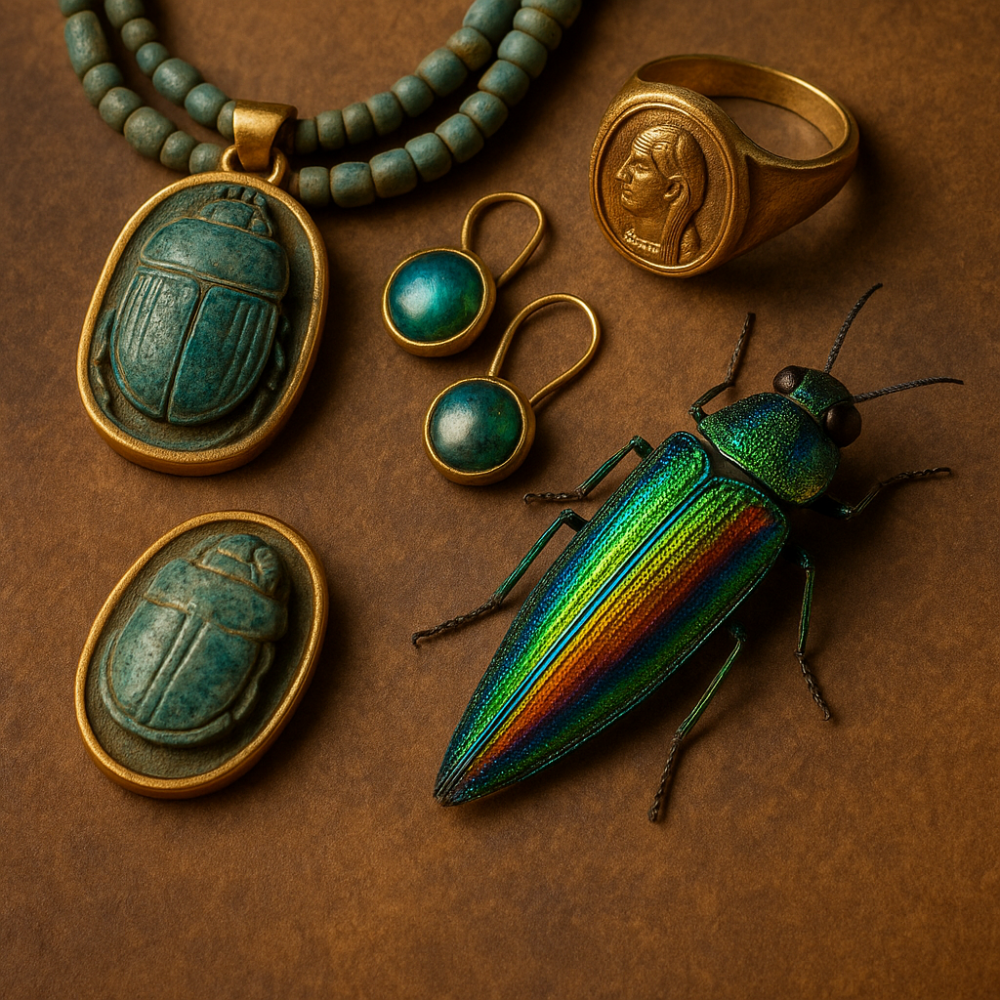
Jewel beetles are like the superstars of the beetle world with their stunning iridescent shells. But these dazzling colors are not just for show. Their glimmering exteriors play a vital role in protection and predator deterrence. These colors can create optical illusions, making it tricky for predators to spot them in the wild.
Their anatomy isn’t only about looking good. Jewel beetles have uniquely structured shells covered with tiny plate-like structures that reflect light, giving them their signature shine. These structures make the beetles more than just eye-candy – they help regulate body temperature by reflecting intense heat, allowing them to thrive in warmer climates.
Camouflage is another trick up their sleeve. Believe it or not, these bright colors actually help them blend in with the dappled sunlight filtering through leaves. To a casual observer or a hungry predator, the beetles simply disappear into their background which is pretty neat if you ask me.
These insects contribute significantly to their ecosystems. Their colorful appearance isn’t just attractive; it indicates a healthy environment, as jewel beetles often thrive where biodiversity flourishes. Observing their presence can be a great way to gauge ecological health.
Cultural Significance and Historical Importance

Jewel beetles haven’t just turned heads in the animal kingdom; they’ve historically dazzled human societies too. Even ancient civilizations saw something special in these glittering insects and used their colorful shells in artifacts and jewelry. For example, in ancient Egypt, jewel beetles were used in ornaments due to their radiant hues, showcasing that our fascination with shiny objects stretches way back.
Across different cultures, jewel beetles pop up in mythology and folklore. In some stories, they are seen as symbols of immortality and transformation, often tied to tales involving metamorphosis and rebirth. Their presence in stories hints at the universal wonder nature inspires with its magical surprises.
In modern times, jewel beetles continue to influence art, fashion, and design. Designers are constantly inspired by their metallic colors, creating everything from fashion pieces to interior decorations. If you’ve ever seen iridescent patterns on textiles or home decor, there’s a good chance they took a few cues from our beetle friends.
Beyond aesthetics, jewel beetles also hold economic importance in some cultures. In certain parts of the world, harvesting these beetles forms part of local livelihoods, showing how deeply intertwined human life and nature can become. It’s intriguing to see how these beetles, so small on their own, can have such a big ripple effect on the cultures around them.
Here are some jewel beetles as seen on postage stamps.
Scientific Discoveries and Research Insights
Jewel beetles have become a hot topic in scientific circles thanks to their fascinating genetics. Researchers are keen to uncover the secrets behind their brilliant coloration, delving into the genetic codes that paint these beetles in such remarkable hues. These insights could eventually pave the way for innovations in materials science and manufacturing, even offering new approaches to create iridescent colors without using harmful chemical dyes.
Nature’s designs are often smarter than anything humans can dream up, and jewel beetles are a perfect example. Their dazzling shells inspire biomimicry, a scientific practice where engineers and product designers borrow nature’s clever solutions. The structure of their shells, famous for reflecting light in vibrant ways, acts as a blueprint for developing new technologies with similar light-reflecting properties. Imagine ultra-lightweight materials that change color based on the angle you’re looking from, all thanks to our beetle buddies!
Beyond their aesthetic value, jewel beetles play a crucial ecological role by contributing to biodiversity. They often thrive in undisturbed environments, where their presence can indicate a healthy ecosystem. This highlights the importance of conserving their habitats, as these beetles might be more integral to our planet’s health than we’ve realized.
Researchers are also intrigued by how these beetles communicate. While they don’t chat like us, they do communicate using subtle chemical signals and vibrations that hold clues about how insects interact with each other. Understanding these communication methods could lead to advancements in pest management and even robotics, where mimicking insect behavior offers cutting-edge technological solutions.
Challenges and Conservation Efforts
Jewel beetles face a range of challenges that threaten their survival. Human activities like deforestation and pollution have been taking a heavy toll, resulting in habitat loss and declining populations. It’s a stark reminder of the broader environmental impact we’re having and how crucial it is to protect natural habitats.
The conservation status of many jewel beetle species is a concern. Some are listed as endangered, which has prompted conservationists and researchers to take action. Efforts include habitat restoration projects and breeding programs aimed at bolstering beetle populations.
One cool aspect of conservation is the role of citizen scientists. Everyday folks with a passion for nature can contribute by documenting beetle sightings and sharing data with researchers. This grassroots approach helps gather valuable data and raises public awareness about the importance of safeguarding these vibrant insects.
Finding a balance between human activities and beetle conservation is key. Adopting sustainable practices, like reduced pesticide use and responsible forestry, can go a long way in preserving their habitats. It’s about finding practical solutions that meet human needs while ensuring these shiny beetles continue to thrive in their natural environments.
Encounters and Engagement: Bringing Jewel Beetles to the Masses
If you’re keen to experience the wonder of jewel beetles for yourself, you’re in luck. Nature enthusiasts can find these colorful critters in various regions, particularly in warm, forested areas. With a keen eye and a good field guide, spotting them can turn an ordinary hike into a dazzling adventure.
Getting involved in beetle exhibitions and educational programs is another excellent way to engage with these insects. Zoos and science museums often host events where you can learn about their behavior, biology, and the efforts in place to conserve them.
Photography is a popular way to capture the enchanting beauty of jewel beetles. Whether you’re an amateur or a seasoned snapper, their vibrant colors make for striking subjects. Join a community of nature photographers to swap tips and showcase your best shots.
Interactive learning experiences offer a fun way to deepen your understanding. Online platforms and local workshops sometimes provide opportunities to engage in citizen science projects, offering hands-on learning and contributing tangibly to beetle conservation efforts. Through these interactions, the marvel of jewel beetles and their importance in the ecosystem becomes truly apparent.
